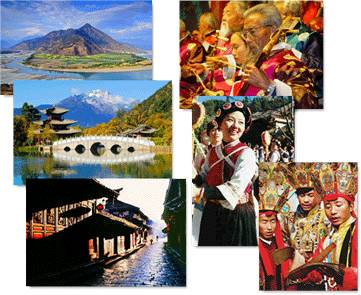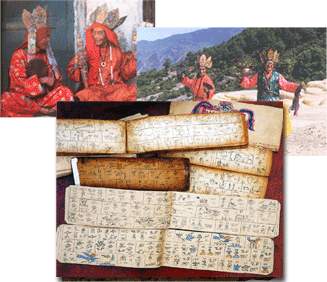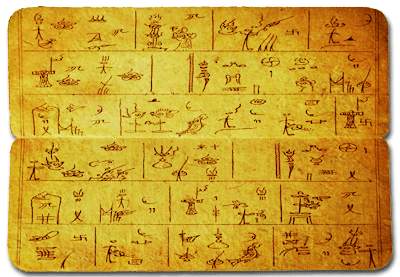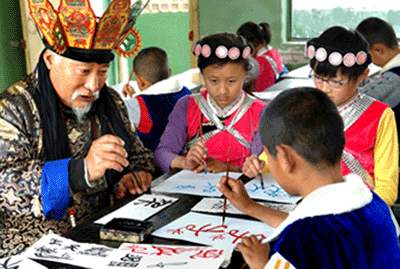| |
About Naxi nationalty and Dongba culture

Mainly inhabited by the Naxi in Lijiang City, Yunnan Province, and the rest distributed in Weixi, Zhongdian, Ninglang, Deqin and Yanbian, Yanyuan, Muli , Sichuan Province. Some other distributed in Zhikang, Tibet. According to historians research, Naxi was a branch of Ancient Qiang people in northwest China, at around the third century AD to move to Lijiang settled. The current population is 324,679 people.
Since ancient times, have had close contacts with the Han Nationality, most people can speak Chinese, until now, Naxi daily diet, lifestyle, culture and so on still have the characteristics of the ancient Han culture in the Central Plains.
Naxi warmhearted and hospitable, everyone can share a prey when met at hunting returned. There is also to retain the characteristics of nomadic people until now. You can always see the young men go out hunting with dog and eagle at Lijiang.
Naxi woman virtuous, hard-working, mothers, homemakers, apparel with star and moon up to show spare any. Naxi man bent on zither, chess, calligraphy and painting, who refined a lot, not the number of young talent; Naxi great importance to scholars, but a time when the country suffered, there is no lack of bloody man in the Lijiang. The "Anti-Japanese War Memorial Monument" was standing at Jade Spring Park to commemorate the officers and men of Naxi who blood battlefield, die on the battlefield at the War of Resistance Against Japan such as Taierzhuang battlefield.

Dongba, the meaning is wise in the Naxi language. They were the highest level intellectuals in ancient times, the majority of set songs, dance, classics, books, history, painting, for a medical, the high status in society, often to engage in religious activity to exorcise, to eliminate of civil disaster, to pray to the gods to bring about human well-being. They were seen as the media for people between to God, and ghost.
Father and son carry on Dongba in general, with the passage of generations, not full-time, has wife and children. Or inherited by the son-in-law who had no son.

Naxi have their own language and writing. Naxi language is a branch of Yi language, generally classified as Sino-Tibetan Tibeto-Burman language. Naxi has two characters: Dongba hieroglyphs and Geba script. Dongba hieroglyph is a kind of original pictograph picture, mainly use by of Dongba to teaching, and writing, so they said as Dongba hieroglyph.
In Naxi language, the Dongba hieroglyph called "Si Jiu Lu Jiu", which means "wood trace stone trace", that is, see wood draw wood, see stone draw stone.
Dongba scholars think the Dongba hieroglyphs is more ancient orginal than the Babylonian cuneiform, the ancient Egyptian language book saint, the Central American Mayan and Chinese Oracle, it is the only one hieroglyph which are still alive in the world, is considered for all mankind valuable cultural heritage. It has a high academic value for comparative study of language and human cultural history. It is the "living fossil" for the origin of human society and language development.
"Geba" is the meaning of disciples for Dongba, "Geba Script" means that characters created by the disciples of the Dongba named "shiluo".
"Geba Script" is the transformation and development of Dongba. Dongba also use it to write two hundred books. This character easy to stroke, and one word one audio, than a step to Dongba hieroglyph.
"Geba Script" although more than 2400 symbols, but more duplicate, only more than 500 commonly used words, marked pronunciation but does not mark tone, instead of a homonym and near a lot of sound, which does not widely use.
However, it has an advantage that the Naxi language has some words can not find the corresponding Dongba hieroglyphs, But the Geba script always has a corresponding map.

Dongba ancient books wrote by the Dongba hieroglyphs, covering to astronomy, calendar, medicine, philosophy, history, religion, literature, art and many other fields. These books, named as "Dongba Encyclopaedia". "Dongba Encyclopaedia" extensive knowledge and profound scholarship, It is the valuable information to examine the Naxi ancient philosophy, religious customs, social history, ethics, ethnic relations, literature, art, lang, etc. Therefore, "Dongba Encyclopaedia" also known as the society of encyclopedia of ancient Naxi.
"Dongba Encyclopaedia" has more than 20,000 copies. China collected has about 9000, the loss of overseas has not yet recovered to about 11,000.
In China, major collection at the Academy of Social Sciences in Yunnan Dongba Culture Research Institute (Lijiang), Lijiang City Museum, the Beijing Library, Lijiang County Library, Central University for Nationalities, Yunnan Province Library, National Museum of Taiwan Province.
The China abroad, the main collection at the Library of Congress, Harvard University Museum, the National Library in Berlin and London, the British Museum. Japan, Austria, Italy, Canada and other countries as well as some collections.

The Dongba Culture had a situation come to a halt because of historical reasons. But a number of pilot schools has been introduced in the Dongba culture from 1995.
More and more people at home and abroad have taken place in Dongba culture of interest and someone research in some special fields with the Dongba culture to gradually improve the well-known.
However, there is not positive place, a number of outland businessman fabricate a lot of wrong Dongba hieroglyphs at travel souvenirs to profit at Lijiang when they limited in the Dongba culture knowledge. They mislead and deceive consumers.
But no matter how to say, It is a miracle. Naxi has created two types of ancient language, and still using these ancient languages.
|
|